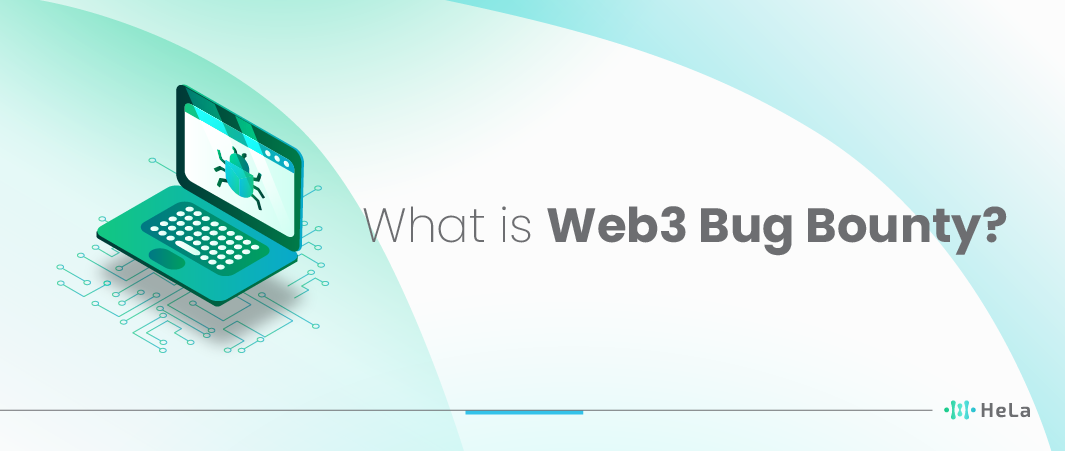The internet has come a long way, and now we find ourselves in the era of Web3. Unlike its predecessors, Web3 is all about decentralization, putting users in the driver’s seat, and leveraging blockchain technology. But as with any groundbreaking change, ensuring its safety is a top priority. This is where the Web3 Bug Bounty comes into play, serving as a crucial component of Web3 security.
So, what exactly is a Web3 Bug Bounty? Well, it’s a system where individuals or groups are encouraged to discover and report vulnerabilities in Web3 platforms, apps, or projects. In return, they receive rewards, often in the form of cryptocurrency. This practice is vital because it helps uncover and fix potential security holes, making the Web3 ecosystem safer for everyone.
Web3 Bug Bounties aren’t just about hunting for issues; they hold immense significance in ensuring the security and stability of this emerging online world. They incentivize a collective effort to identify and address vulnerabilities, ultimately paving the way for a more secure and user-friendly Web3 experience. So, as Web3 continues to evolve, Bug Bounties will remain a cornerstone in maintaining its safety and integrity.
Understanding Web3: A Quick Refresher
To understand the concept of Web3, think of it as the evolution of the internet. It’s like the internet’s cool, new upgrade. Web3 relies on blockchain technology to create a space where people can interact directly with one another, without the need for middlemen.
This means you can send money, share data, or engage in all sorts of online activities without relying on big companies to facilitate these transactions. It’s like the internet’s becoming a peer-to-peer playground! But, and here’s the twist, this new way of doing things also introduces some unique challenges, especially when it comes to security. This is where Web3 Bug Bounty programs come into play.
Now, let’s talk about these Web3 Bug Bounties. They’re like the internet’s own detectives. In this decentralized world of Web3, where everyone’s interacting directly, security becomes a paramount concern. To ensure that Web3 platforms are safe and sound, organizations launch Bug Bounty programs. These programs invite tech-savvy folks to find and report any security issues or bugs they stumble upon.
It’s a bit like a game where you hunt for vulnerabilities, and when you find one, you get rewarded for your skills. These Bug Bounties are essential in making Web3 a safer place for all of us to play, work, and connect. So, in a nutshell, Web3 is all about decentralized, direct interactions, and Web3 Bug Bounties are here to make sure it’s as safe as possible.
What is a Bug Bounty?
A Bug Bounty is like a digital treasure hunt that companies and organizations organize to encourage friendly hackers to uncover and report any flaws or weaknesses in their software. These helpful hackers, often called “white-hat hackers,” get rewarded with a bounty for their efforts. The whole idea behind it is to spot and fix potential security issues before any bad actors can exploit them. This concept has become even more prominent in the world of Web3, where security is a big deal.
In a nutshell, a Web3 Bug Bounty is like a high-stakes game where tech-savvy individuals hunt for vulnerabilities in the latest Web3 technologies. When they find a security gap, they report it to the company or project responsible, and in return, they receive a cash reward. This system encourages collaboration and helps ensure that the Web3 world remains safe and secure for everyone to use. So, if you’re a tech whiz with an eye for spotting digital weak points, Web3 Bug Bounties might be your kind of gig!
Why are Web3 Bug Bounties Essential?

Web3 Bug Bounties are essential for a variety of reasons, primarily revolving around the security and reliability of decentralized applications (DApps), smart contracts, and blockchain protocols. Here’s some additional context:
Security and Trustworthiness
Web3 encompasses blockchain technology and decentralized platforms, which often handle valuable assets and sensitive data. Bug bounties play a crucial role in identifying and mitigating vulnerabilities in these systems. They help ensure the security and trustworthiness of these platforms by allowing security experts and the broader community to scrutinize the code for potential flaws.
Rapid Innovation
Web3 technologies are evolving quickly, and the landscape is dynamic. Bug bounties encourage continuous innovation by providing an extra layer of security to these evolving technologies. This allows developers to experiment with new features and functionalities without compromising the overall system’s integrity.
Community Involvement
Bug bounties provide an opportunity for community involvement. They enable individuals from around the world to contribute to the security of these systems. This decentralized approach harnesses the collective intelligence of the community, which is especially valuable in Web3, where decentralization is a key principle.
Also Read: What Is Cryptocurrency Transaction Speed? Blockchain Scalability Explored
Reducing Exploitation
Without bug bounties, vulnerabilities might go unnoticed and could be exploited by malicious actors. Identifying and fixing these issues proactively helps prevent hacks, fraud, and other security breaches that can have severe financial and reputational consequences for Web3 projects.
Economic Incentives
Bug bounties offer economic incentives for security researchers and hackers to responsibly disclose vulnerabilities rather than exploiting them for personal gain. This “white-hat” approach helps align the interests of security experts with the goals of Web3 projects.
Compliance and Regulation
As Web3 technologies gain mainstream adoption, they are subject to increasing regulatory scrutiny. Implementing robust security measures, such as bug bounty programs, can help Web3 projects demonstrate their commitment to compliance and protecting users’ assets and data.
Continuous Improvement
Bug bounties create a feedback loop for improvement. As vulnerabilities are discovered and fixed, the ecosystem becomes more robust. Over time, this iterative process leads to a more secure and reliable Web3 infrastructure.
Web3 bug bounties are essential for maintaining the security, trustworthiness, and continuous development of decentralized systems. They engage the community, incentivize responsible disclosure, and help prevent security breaches and data compromises, all of which are critical for the success of Web3 technology in various applications, including DeFi, NFTs, supply chain management, and more.
How to Participate in a Web3 Bug Bounty

Participating in a Web3 Bug Bounty program can be an exciting and rewarding way to contribute to the security and integrity of blockchain and decentralized applications. To help you get started on this ethical hacking journey, here’s a more detailed guide on how to participate in a Web3 Bug Bounty:
Research the Web3 Platform
Start by selecting a Web3 platform or project that piques your interest. It’s important to choose a project that aligns with your expertise and passion.
Dive deep into understanding the architecture, smart contracts, and overall functionality of the chosen Web3 project. You need to know how the system works inside and out.
Educate Yourself
Building a strong foundation in blockchain technology and Web3 security is crucial. Invest time in learning about blockchain concepts, cryptography, and decentralized applications (dApps).
Take advantage of the various educational resources available, such as online courses, whitepapers, and documentation. There are platforms like Coursera, edX, and Udemy that offer courses on blockchain and cryptocurrency.
Stay Informed and Network
Join online forums, social media groups, and discussion boards dedicated to Web3 and blockchain. Engage in conversations, ask questions, and follow the latest trends and news.
Attend blockchain and Web3-related conferences, workshops, and meetups. Networking with professionals in the field can provide valuable insights and connections.
Join a Bug Bounty Platform
Register on popular bug bounty platforms such as HackerOne, Bugcrowd, or other platforms that host Web3 projects looking for security evaluations.
Browse through the available bug bounty programs and look for projects that match your expertise and interests. Each program will have its own guidelines, scope, and reward structure.
Review Bug Bounty Program Guidelines
Before you start testing, carefully read and understand the guidelines and scope provided by the bug bounty program. This will specify what is considered fair game for testing and what isn’t.
Conduct Security Testing
Utilize your knowledge and skills to search for vulnerabilities in the Web3 project. Common vulnerabilities include smart contract flaws, injection attacks, and authentication issues.
Employ various tools and techniques like automated scanners, manual testing, and code analysis. Keep detailed records of your findings.
Responsible Disclosure
If you discover a vulnerability, follow the responsible disclosure process outlined in the bug bounty program’s guidelines. This typically involves reporting the issue to the project’s maintainers or developers.
Continuous Learning
Web3 technology is constantly evolving, with new platforms, tokens, and protocols emerging regularly. Stay up to date with the latest developments and vulnerabilities in the field. Continuously improve your skills and adapt to changing security paradigms.
By following these steps, you can actively participate in a Web3 Bug Bounty program, contribute to the security of decentralized systems, and potentially earn rewards for your ethical hacking efforts. Remember that ethical hacking requires a strong commitment to responsible disclosure and ethical behavior, as your findings will help protect the integrity of Web3 platforms for users and investors.
Success Stories: When Web3 Bug Bounties Made a Difference

In the ever-evolving world of Web3, bug bounties have played a pivotal role in safeguarding the integrity of blockchain and decentralized applications. These initiatives have not only become a vital tool for identifying vulnerabilities but have also led to several remarkable success stories that highlight their profound impact on the industry.
Multi-Million Dollar Saves
Some Web3 projects, ranging from decentralized finance (DeFi) platforms to blockchain infrastructure providers, have experienced near-disastrous scenarios that could have resulted in potential losses amounting to millions of dollars.
However, thanks to vigilant ethical hackers participating in bug bounty programs, catastrophic financial crises were averted. These instances underscore the undeniable value of the Bug Bounty ecosystem, demonstrating that the proactive identification and remediation of vulnerabilities can save not only money but also the reputations of these projects.
Reputation Building
Companies that actively and transparently engage with their Bug Bounty programs have found that they can enhance trust and reputation within the Web3 community. By openly inviting security experts and ethical hackers to assess their systems, they signal a commitment to maintaining the highest security standards.
In doing so, they not only benefit from vulnerability identification and mitigation but also foster a culture of trustworthiness, which can be a significant asset in an industry that relies on decentralized networks and smart contracts. These organizations often become beacons of security, drawing users and investors who value a commitment to robust, secure systems.
Also Read: Top Layer 1 (L1) Dominating the Crypto Market
Cultivating Talent
Bug Bounties have acted as more than just security safeguards; they have also acted as springboards for talented individuals looking to enter the Web3 security sector. Ethical hackers who successfully identify vulnerabilities in Web3 projects often gain recognition and trust within the industry.
This recognition can open doors for these individuals to transition into full-time roles as security experts, auditors, or consultants. In this way, bug bounty programs not only secure existing projects but also contribute to the growth of the Web3 security workforce, creating a win-win situation for both the projects and the individuals involved.
These success stories showcase the critical role that bug bounties play in the Web3 ecosystem, from protecting assets and reputations to nurturing a talented and dedicated security community. As the Web3 space continues to expand, bug bounty programs will remain an essential tool in ensuring its security and resilience.
Conclusion
The rise of Web3 has ushered in a wave of opportunities and challenges. While its decentralized nature promises empowerment and autonomy, it also accentuates the need for robust security measures. Web3 Bug Bounties have proven to be a formidable solution in this respect, bridging the gap between platforms and the community, and ensuring a safer ecosystem for everyone.
As we forge ahead into this new digital frontier, the symbiotic relationship between Web3 platforms and ethical hackers will only grow in significance. The world of Web3 Bug Bounties is not just about finding flaws; it’s about building a resilient, trustworthy, and inclusive future for the internet.
In embracing this spirit, we are not just safeguarding code and assets; we are protecting the very ethos of Web3 – a world where everyone has a stake, and everyone plays a part in its well-being.
Disclaimer: The information provided by HeLa Labs in this article is intended for general informational purposes and does not reflect the company’s opinion. It is not intended as investment advice or recommendations. Readers are strongly advised to conduct their own thorough research and consult with a qualified financial advisor before making any financial decisions.

Hi, I'm Carina, and I've been captivated by the world of web3 for as long as I can remember. Ever since I first dipped my toes into this innovative technology, I've found myself drawn to exploring and understanding its infinite potential. The complexities of layer 1 solutions particularly intrigue me, as they form the foundation of decentralized networks and pave the way for a more transparent and efficient digital landscape.
-
Carina Caringalhttps://helalabs.com/blog/author/carina-caringal/
-
Carina Caringalhttps://helalabs.com/blog/author/carina-caringal/
-
Carina Caringalhttps://helalabs.com/blog/author/carina-caringal/
-
Carina Caringalhttps://helalabs.com/blog/author/carina-caringal/

